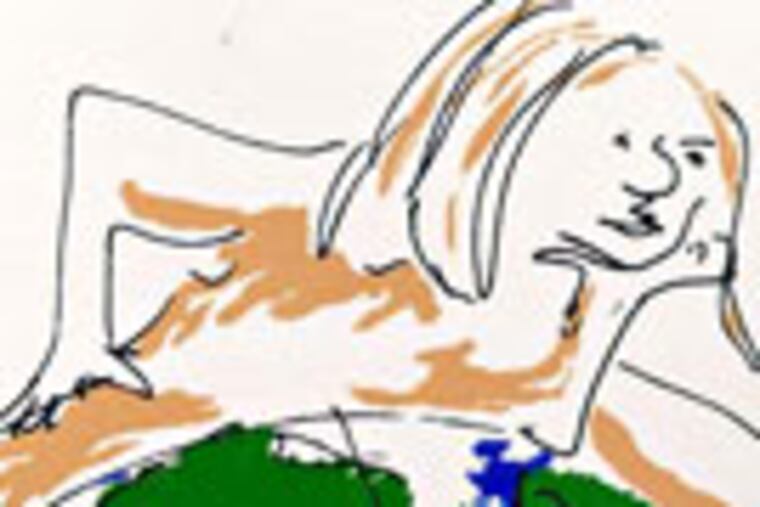Yoko Ono brings John Lennon's artworks to Manayunk
'John never expected anything like this would happen - yet he would have loved the fact that it's happening." The speaker is Yoko Ono. "John" is, of course, her husband, John Lennon, Beatle, peace activist, and artist, who was murdered in 1980.

'John never expected anything like this would happen - yet he would have loved the fact that it's happening."
The speaker is Yoko Ono. "John" is, of course, her husband, John Lennon, Beatle, peace activist, and artist, who was murdered in 1980.
It's a shock to reflect that Lennon would have turned 70 last Oct. 9. An exhibition of his artwork, titled "Yoko Ono Presents 'Imagine Peace': A Visual Tribute to John's 70th Year," runs in Manayunk Friday through Sunday, to raise funds for North Light Community Center, on Green Lane.
Yoko and John are among the most famous couples in pop history. She was and is a serious conceptual and performance artist who had a big impact on his art, social activism, and music. His art is itself a great story - as is the tale of how "Imagine Peace" made its way to Manayunk.
"John's drawings were like a security blanket," Ono says, by phone. "At a lot of our endless meetings with lawyers and accountants, John would be there, just drawing, listening with one ear, but mostly drawing whatever. Afterward, a lawyer might ask, 'Can I have it?' and John would say, 'Sure, here, take it.' "
Those drawings, sometimes deceptively naive, range from the silly (An Elephant Counting) to the satirical, from the erotic to the political (Give Peace a Chance). "He was not one of these serious-face artists, making a big statement," Ono says, "but he did care about what he was doing. He'd show me something and ask, 'What do you think of this one?' And if he didn't like it, he'd crumple it up and throw it in the wastebasket. Although" - this said with a chuckle - "some of them somehow made their way out of the wastebasket again. It's an opportunity to have a conversation with him, to see where he was, and to see where you are."
The Manayunk exhibition features more than 100 artworks, four of them only recently made public, and lyric sheets. (Some are not originals, but lithographs or reproductions.) "Imagine Peace" has traveled the country for 20 years, benefiting selected local charities. Founded as a boys' club in 1936, North Light has undergone several expansions, and now includes art and recreational offerings and children's and family programs.
How did "Imagine Peace" find Manayunk and North Light? Legacy Productions works with Ono and the Lennon estate to do 25 of these exhibitions a year. "We get a lot of requests," Ono says, "and we check the town and set it up." In past years, the show has come to places such as New Hope, Haddonfield, and Rittenhouse Square. "I do select the art works to be used," Ono says, "but the actual curator of the individual shows can make changes."
Rudy Siegel, a producer at Legacy, says, "The folks from the Manayunk Development Corporation [MDC] gave us the heads-up about North Light. That's usually how it happens around the country: Someone local will turn us on to a worthy nonprofit that's in the community where we can raise funds and awareness for them through the exhibit."
The Manayunk people involved are Beatles fans. Karen Smith, director of marketing and communications at North Light, says: "Obviously, I'm thrilled North Light was chosen, and I'm also thrilled because I love John Lennon's work, and his music and art, and I just think Yoko is brilliant."
Jane Lipton, executive director of the MDC, has also been on the board of North Light, and she helped put Legacy and North Light together. The challenge, she says, was finding a building big enough to house such a large show.
Enter real estate guy Sam Kroungold, who owns the former Propper Brothers furniture building. He gave the show a great deal: free space.
"I'm a Beatles maniac from way back," says Kroungold. "I spent a lot of time enjoying John Lennon's music and life, and that of all the Beatles. And this is for the kids. How can you not feel blessed to be a part of something like that?"
Lennon met Ono in 1966, when he was already a published writer and artist (In His Own Write, 1964, and A Spaniard in the Works, 1965). She, in turn, was already a well-established performance artist. She's also someone drawn to collaboration, having worked with everyone from Ornette Coleman to Lady Gaga. That collaborative bent also has led to her recent resurgence as a disco phenom, with a string of No. 1 dance hits in recent years, including a remix of "Move On Fast," which hit No. 1 the week of March 17.
"I think of this exhibit as a chance to keep collaborating with John," Ono says. "In my own work, I've always made things, and then made a point of inviting people to come up and show their own creativity. It's much the same here." Lennon, she says, liked the idea of his art circulating, becoming a meeting point for people.
Which feeds into the notion of this being for children, and for peace. "Right now, the world is pretty bleak, a lot of violence going on," Ono says. "If you go to John's exhibit, it's a tiny thing, but it's an oasis for many people to come check it out, weigh what they are thinking, find like minds there. He'd love knowing that, in a world very different from the one John and I lived in, his art can still have impact."